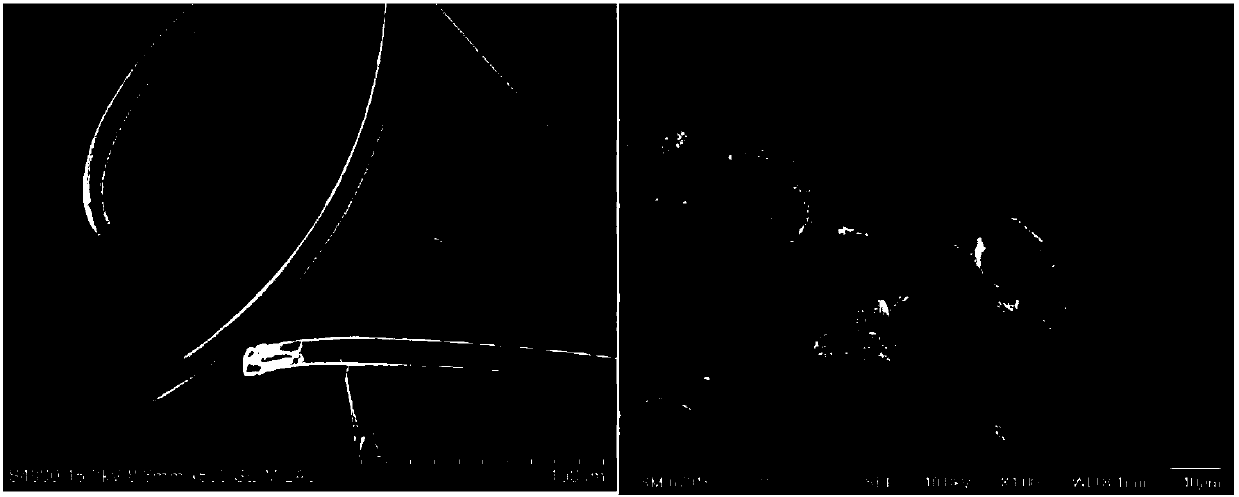Modified carbon material and redox flow battery electrode modified by graphene-like nanosheet prepared from same
A carbon material, flow battery technology, applied in battery electrodes, circuits, electrical components, etc., can solve problems such as poor structural stability, difficult industrial application, etc., to reduce polarization, simple and easy preparation methods, and improve voltage efficiency. and energy efficiency
- Summary
- Abstract
- Description
- Claims
- Application Information
AI Technical Summary
Problems solved by technology
Method used
Image
Examples
Embodiment 1
[0041]Add 25mL of phytic acid aqueous solution (2ml of 60wt% phytic acid solution dispersed in 23mL of water) into a 200mL beaker, and sonicate for 10min to obtain a homogeneous liquid. Immerse a graphite felt of a certain size in the phytic acid solution, add 10ml of urea aqueous solution (0.1-1.0g urea dispersed in 10mL of water) under the condition of an ice-water bath, and mix the two reactants evenly by ultrasonic treatment. Control the temperature of the reaction system to room temperature (20-40° C.) and react for 3-5 hours to obtain a graphite felt uniformly deposited with phytic acid-urea polymer flakes, and dry it at 60° C. overnight.
[0042] Place the graphite felt prepared above with uniform deposition of phytic acid-urea polymer sheet polymer in a tube furnace, under the protection of an inert gas, and calcinate at 800°C for 1 hour to obtain a nitrogen-phosphorus co-doped graphite felt composite material, its SEM image is shown in figure 2 .b, from figure 2 ....
Embodiment 2
[0045] Add 25mL phytic acid aqueous solution (1mL 60wt% phytic acid solution dispersed in 24mL water) into a 200mL beaker; sonicate for 10min to obtain a homogeneous liquid. Immerse graphite felt of a certain size in the phytic acid solution, add 10ml of urea aqueous solution (0.1-0.5g of urea dispersed in 10mL of water) under the condition of ice-water bath, and mix the two reactants evenly by ultrasonic treatment. Control the temperature of the reaction system to room temperature (20-40° C.) and react for 3-5 hours to obtain graphite felt with evenly deposited phytic acid-urea polymer flakes, and dry it at 60° C. overnight.
[0046] Place the graphite felt prepared above with uniform deposition of phytic acid-urea polymer sheet polymer in a tube furnace, under the protection of an inert gas, and calcinate at 800°C for 1 hour to obtain a nitrogen-phosphorus co-doped graphite felt composite Material.
[0047] The above-mentioned graphite felt composite material was prepared i...
Embodiment 3
[0049] Add 25 mL of phytic acid aqueous solution (4 mL of 60 wt % phytic acid dispersed in 21 mL of water) into a 200 mL beaker; and sonicate for 10 min to obtain a homogeneous liquid. Immerse graphite felt of a certain size in the phytic acid solution, add 10ml of urea aqueous solution (1-2g of urea dispersed in 10mL of water) under the condition of ice-water bath, and mix the two reactants uniformly by ultrasonic treatment. Control the temperature of the reaction system to room temperature (20-40° C.) and react for 3-5 hours to obtain graphite felt with evenly deposited phytic acid-urea polymer flakes, and dry it at 60° C. overnight.
[0050] Place the graphite felt prepared above with uniform deposition of phytic acid-urea polymer sheet polymer in a tube furnace, under the protection of an inert gas, and calcinate at 800°C for 1 hour to obtain a nitrogen-phosphorus co-doped graphite felt composite electrode.
[0051] The above-mentioned graphite felt composite material was...
PUM
 Login to View More
Login to View More Abstract
Description
Claims
Application Information
 Login to View More
Login to View More - R&D
- Intellectual Property
- Life Sciences
- Materials
- Tech Scout
- Unparalleled Data Quality
- Higher Quality Content
- 60% Fewer Hallucinations
Browse by: Latest US Patents, China's latest patents, Technical Efficacy Thesaurus, Application Domain, Technology Topic, Popular Technical Reports.
© 2025 PatSnap. All rights reserved.Legal|Privacy policy|Modern Slavery Act Transparency Statement|Sitemap|About US| Contact US: help@patsnap.com


